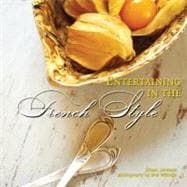
| Introduction | p. 7 |
| In the Medieval Town of Saignon Breakfast in Bed | p. 13 |
| Celebrating Moroccan Influence on French Cuisine Luncheon | p. 25 |
| In L'isle Sur La Sorgue, the Antiques Capital of France Garden Lunch | p. 37 |
| In the Countryside near Provence Three-Course Dinner | p. 49 |
| In the Village of Maillane Classic French Breakfast | p. 63 |
| In the Heart of Burgundy Cooking with Flowers | p. 75 |
| In La Perche Dinner and Calvados | p. 89 |
| Quintessentially Paris Dining In a Left Bank New York City Apartment | p. 105 |
| Table of Contents provided by Publisher. All Rights Reserved. |
The New copy of this book will include any supplemental materials advertised. Please check the title of the book to determine if it should include any access cards, study guides, lab manuals, CDs, etc.
The Used, Rental and eBook copies of this book are not guaranteed to include any supplemental materials. Typically, only the book itself is included. This is true even if the title states it includes any access cards, study guides, lab manuals, CDs, etc.
WHEN READING ABOUT THE AREA of La Perche in France 115 one often hears the French expression terroir. Terroir can be defined variously as soil or the land, and it is constantly used in relationship to wine, but the word means so much more than that. Terroir is the relationship of food to the land and the people who cultivate the land. It is the animals that graze upon the land, the agriculture, and the integrity of the food grown specifi c to the area. It is the angleof the sun, the accumulation of the rain, and the geographical location that makes up terroir. UNESCO's defi nition of the term is, in part, as follows:
"Terroirs" are vibrant and innovative spaces that defi ne the people who live there and refl ect a marriage between traditions, culture, and the natural environment."